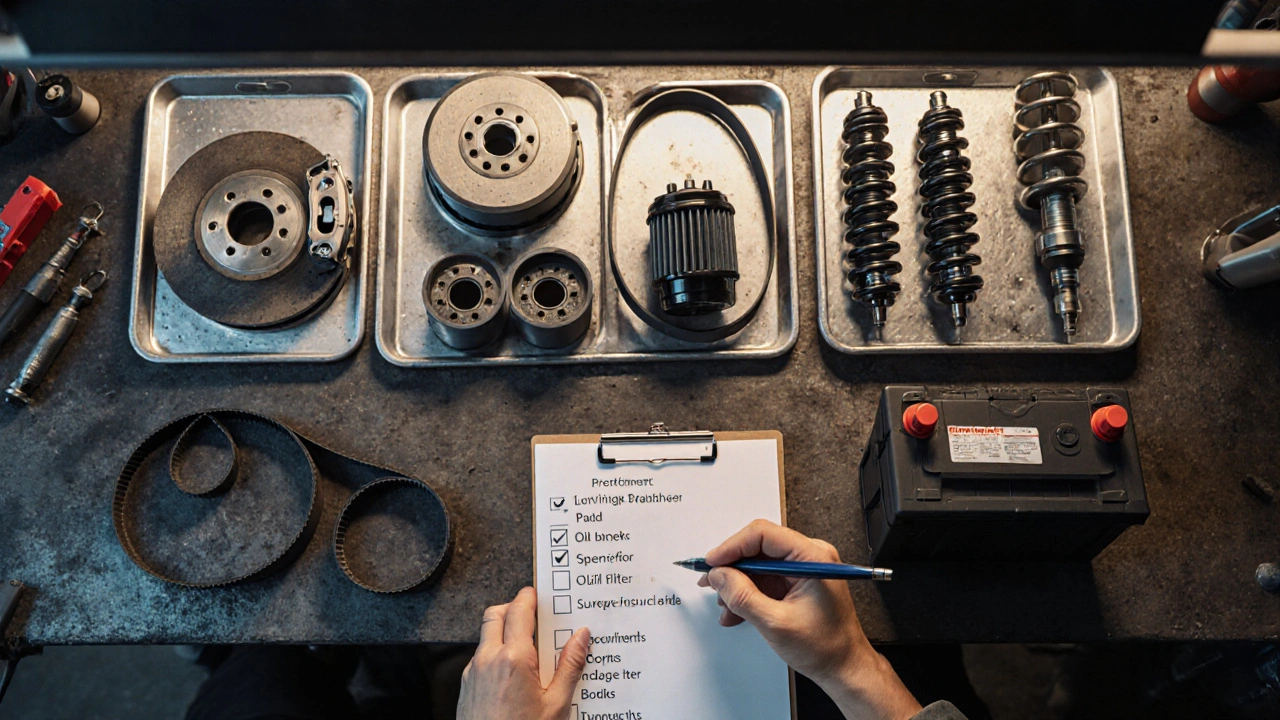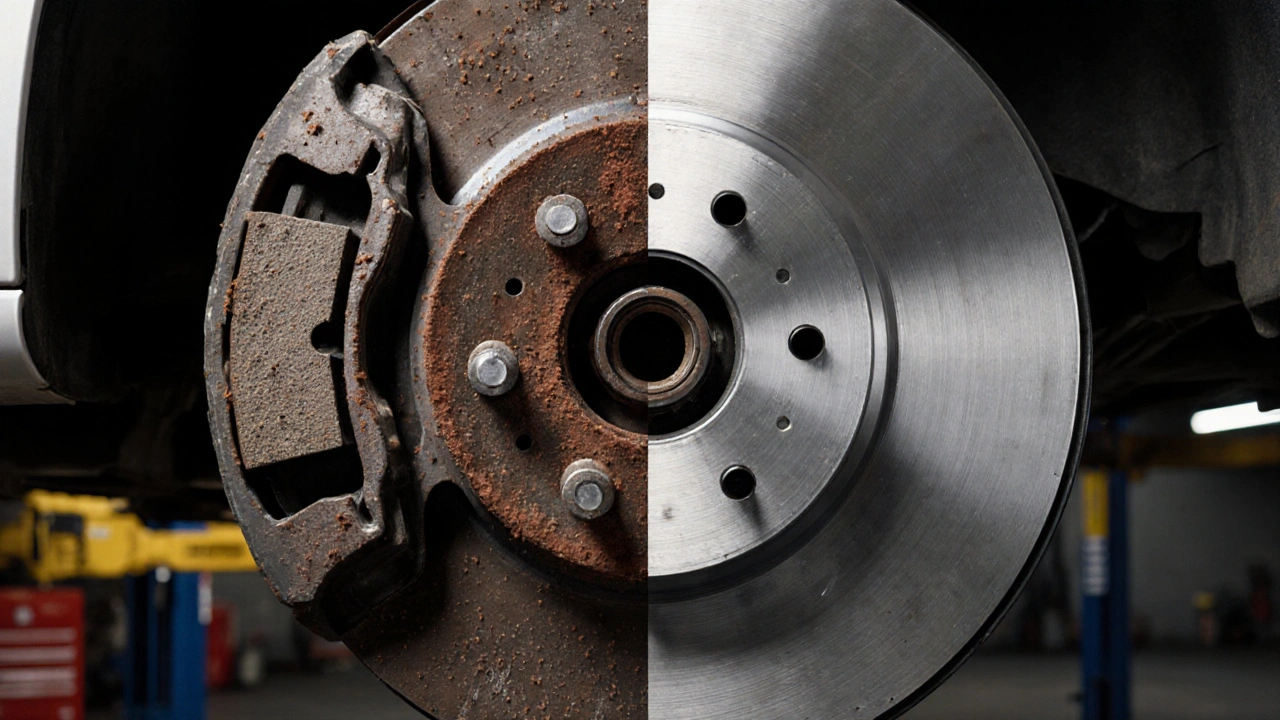Car Parts Cost Comparison Calculator
Compare Your Costs
See how much you could save by choosing quality parts over cheaper alternatives. Enter your vehicle usage details to get a personalized analysis.
Cost Comparison Results
Cheap Parts
Annual Cost:
Total Cost (5 years):
Quality Parts
Annual Cost:
Total Cost (5 years):
Savings Analysis
Over years, you could save by choosing quality parts.
Choosing quality parts not only saves money but improves safety and vehicle reliability.
When it comes to car parts the components that keep a vehicle running safely and efficiently, most owners face a simple question: spend a little now and replace often, or pay more upfront for something that lasts? The answer isn’t about price tags alone; it’s about safety, resale value, and the hidden costs of frequent repairs.
Key Takeaways
- High‑quality car parts reduce long‑term expenses and improve safety.
- OEM (original equipment manufacturer) parts typically outperform low‑cost aftermarket options for critical components.
- Look for certifications, proper fit‑ment, and reputable sources when shopping.
- Investing in durability pays off in resale value and lower downtime.
- A systematic checklist can help you avoid cheap‑quality pitfalls.
Why Quality Matters More Than a Low Price
Cheap parts might seem like a bargain on a receipt, but they often trigger a chain reaction of hidden costs. A low‑grade brake pad can wear unevenly, forcing you to replace rotors sooner. A substandard oil filter may let contaminants slip through, shortening engine life. Those extra trips to the shop pile up, turning an initial $20 saving into $200 or more in labor and part replacements within a year.
Beyond money, safety is the biggest factor. Critical systems-braking, steering, cooling-rely on parts that meet strict tolerance levels. When a part fails because it was under‑engineered, the risk of an accident escalates dramatically. In many jurisdictions, insurance companies will refuse claims if a crash is linked to a known faulty aftermarket component.
OEM Parts vs. Aftermarket Parts
Two main categories dominate the market: OEM Parts components made by the vehicle’s original manufacturer and Aftermarket Parts pieces produced by third‑party vendors. Both have pros and cons, and the right choice depends on the part’s role in the vehicle.
| Aspect | OEM | Aftermarket |
|---|---|---|
| Fit‑ment | Exact match to vehicle specifications | Varies; may require modifications |
| Quality Assurance | Factory‑tested, often under warranty | Depends on brand; some meet or exceed OEM standards |
| Price | Higher upfront cost | Usually cheaper, but price gaps narrow for premium brands |
| Warranty Coverage | Usually 12‑24 months, transferable | Varies widely; some offer limited warranties |
| Resale Impact | Maintains original vehicle value | May lower resale value if perceived as low‑grade |
For safety‑critical components-brake pads, timing belts, and steering knuckles-most experts lean toward OEM. For accessories or non‑essential upgrades, reputable aftermarket brands can be a cost‑effective alternative.

High‑Risk Parts Where Quality Is Non‑Negotiable
Not every part deserves the same level of scrutiny. Here are five areas where you should always prioritize quality:
- Brake Pads friction material that presses against rotors to slow the vehicle. Inferior pads produce uneven wear, longer stopping distances, and noisy squeal.
- Oil Filters devices that trap contaminants before oil circulates through the engine. Cheap filters can clog or leak, risking engine wear.
- Timing Belt synchronizes crankshaft and camshaft rotations. A failure can cause catastrophic engine damage.
- Suspension Bushings rubber or polyurethane inserts that absorb road shock. Low‑grade plastics crack quickly, leading to poor handling.
- Battery stores electrical energy for starter and accessories. Cheap batteries lose capacity fast, leaving you stranded.
Choosing OEM or a reputable premium aftermarket brand for these parts usually saves money in the long run.
How to Evaluate Part Quality Before Purchase
Follow this quick checklist to separate “good enough” from “cut‑corners”:
- Certification Marks: Look for ISO, SAE, or TUV certifications. These indicate that the part meets international safety standards.
- Part Number Match: Verify that the manufacturer’s part number aligns with your vehicle’s VIN‑specified code. Mismatched numbers often signal a generic fit‑ment.
- Brand Reputation: Brands with a proven track record-such as Bosch, Brembo, or Denso-often invest in R&D and testing.
- Warranty Terms: A clear, transferable warranty shows confidence in durability. Avoid parts with “no warranty” clauses.
- Customer Reviews: Look for consistent feedback on fit, lifespan, and performance. A pattern of early failures is a red flag.
When buying online, check if the seller provides a return policy. If you’re at a local shop, ask to see the original packaging or certification documents.

Long‑Term Financial Benefits of Investing in Quality
Let’s run a simple example. Suppose a driver replaces brake pads every 12,000 miles with $35 aftermarket sets, paying $150 in labor each time. Over 60,000 miles, that’s $900 in parts plus $750 in labor-$1,650 total.
If the same driver opts for $70 OEM pads, the replacement interval stretches to 20,000 miles, resulting in just three changes over 60,000 miles. Parts cost $210, labor $450, totaling $660. The premium upfront cost saves $990 in just five years, not counting the added safety margin.
Beyond direct savings, quality parts help maintain Resale Value the projected market price of a used vehicle. Buyers are willing to pay 5‑10 % more for a car with documented OEM maintenance, effectively recouping part expenses.
Practical Steps to Buy Quality Car Parts
- Identify the exact part needed: Use your vehicle’s VIN or consult the owner’s manual to get the official part number.
- Research reputable sources: Certified dealerships, authorized distributors, and well‑reviewed e‑commerce platforms are safer bets than unknown street vendors.
- Compare OEM and premium aftermarket options: Use the table above as a reference, focusing on warranty, fit, and brand reputation.
- Check for certifications and warranty details before adding to cart.
- Order a sample or small batch first if you’re testing a new aftermarket brand-install it, monitor performance, then decide on bulk purchases.
- Keep documentation: Save receipts, warranty cards, and installation records. They’re useful for future resale and warranty claims.
Following this routine turns part shopping from a guessing game into a strategic investment.
Frequently Asked Questions
Are aftermarket parts always cheaper than OEM?
Not necessarily. While many aftermarket parts have lower price tags, premium brands can match or even exceed OEM quality at a comparable price. The key is to compare certifications, warranties, and reviews rather than assuming cheaper equals better.
Will using low‑cost parts void my vehicle warranty?
If a part causes damage, the manufacturer may deny a warranty claim. This is why it’s safer to stick with OEM or certified aftermarket components for critical systems.
How can I verify a part’s compatibility?
Cross‑check the part number with your VIN using the manufacturer’s online catalog or a trusted parts database. A perfect match guarantees fit‑ment and performance.
What are the signs that a brake pad needs replacement?
Squealing noises, a soft pedal feel, or a visual inspection showing less than 3 mm of friction material are clear indicators that it’s time for new pads.
Is it worth paying extra for a premium oil filter?
Yes, especially for high‑performance or high‑mileage engines. Premium filters offer better media efficiency and longer service intervals, reducing the risk of engine wear.
Choosing quality over sheer quantity may feel like a bigger bite at the checkout, but the payoff shows up in fewer breakdowns, lower overall costs, and a safer ride. Next time you face a part decision, remember the checklist, the warranty, and the long‑term value-your wallet and your safety will thank you.






Nicholas Zeitler
October 22, 2025 AT 13:15Great point about checking the part numbers!! It’s amazing how a simple VIN cross‑check can save you from a costly mismatch!! Always double‑check the OEM code before you click "buy"!!
Teja kumar Baliga
November 1, 2025 AT 22:15Using the certification stickers as a quick visual cue helps you spot genuine parts fast. A short lookup on the brand’s website confirms if they meet ISO standards. It’s a small habit that brings big peace of mind.
k arnold
November 11, 2025 AT 18:21Sure, because overrated OEM parts totally *don’t* last any longer.
Tiffany Ho
November 21, 2025 AT 00:35Keeping the receipt and warranty card in a folder is a simple step that pays off later when you sell the car or need a claim.
michael Melanson
November 29, 2025 AT 16:55Buying from a dealer with a solid return policy gives you a safety net if the part doesn’t fit as expected.
lucia burton
December 7, 2025 AT 19:21When you delve into the thermodynamic efficiency of engine cooling circuits, the choice of a high‑flow radiator core becomes a pivotal factor in maintaining optimal operating temperatures; a low‑grade radiator simply cannot dissipate heat at the required rate, leading to thermal stress on pistons and head gaskets. Moreover, the material composition of the core-whether aluminum with its superior conductivity or the older copper‑brass alloys-directly influences heat exchange coefficients, which in turn affect fuel consumption metrics over the vehicle’s lifespan. Selecting an OEM‑spec radiator ensures that the fin density aligns with the manufacturer’s design criteria, thereby guaranteeing the intended airflow dynamics. In contrast, a budget aftermarket unit often compromises on fin spacing, creating turbulence that reduces overall heat transfer efficiency. The downstream impact manifests as increased engine wear, higher oil degradation rates, and a measurable uptick in emissions output, all of which erode the vehicle’s resale value. Another critical component is the timing belt; a premium OEM belt employs reinforced fiber construction and precise tooth geometry, which synchronizes crankshaft and camshaft rotations with micron‑level accuracy. Inferior belts made from generic rubber lack this reinforcement, risking slippage that can catastrophically damage valve train components. Investing in a high‑grade belt, even at a premium cost, eliminates the need for premature replacement cycles and safeguards the engine’s integrity. Similarly, brake caliper pistons fabricated from cast iron versus lightweight aluminum alloys present a trade‑off between durability and unsprung mass; OEM‑grade pistons are calibrated to deliver consistent hydraulic pressure, reducing pedal sponginess and uneven pad wear. When you opt for a reputable aftermarket brand that matches or exceeds OEM specifications, you benefit from rigorous testing protocols-including hydraulic pressure endurance tests and thermal cycling-that certify performance parity. The cumulative effect of these diligent selections is a reduction in unplanned downtime, a smoother driving experience, and tangible cost savings when you calculate total ownership over ten thousand miles. Remember to log each part installation, attach the warranty documentation, and update the vehicle’s maintenance ledger; this systematic approach not only streamlines future service visits but also enhances buyer confidence should you decide to trade in the car. Lastly, leverage the power of community forums and professional networks to cross‑verify part authenticity; peer‑reviewed feedback often uncovers subtle discrepancies that manufacturer literature may overlook. By integrating these best practices into your part‑procurement workflow, you transform a routine transaction into a strategic investment that maximizes performance, safety, and long‑term financial return.
Denise Young
December 15, 2025 AT 07:55It’s fascinating how some shoppers treat the “cheap‑and‑cheerful” aisle like a treasure trove, ignoring the fact that a subpar brake pad’s friction coefficient can be wildly inconsistent, leading to variable stopping distances-great for thrill‑seekers, not for everyday commuters. When you layer in the wear‑rate calculations that OEM manufacturers publish, the cost per mile of a premium pad dramatically undercuts the headline price of a budget alternative. Think of it as a risk‑adjusted investment: you spend a bit more now, and the probability of a costly emergency brake repair plummets. The industry jargon-terms like “fade resistance” and “thermal stability”-isn't just marketing fluff; it reflects rigorous lab testing that ensures the component behaves under extreme conditions. By aligning your purchase with parts that carry ISO‑9001 certification, you’re essentially buying a guarantee that the product has survived a battery of quality audits. So, while the bargain bin may look tempting, remember that you’re paying with your peace of mind and, eventually, your wallet.
Sam Rittenhouse
December 22, 2025 AT 06:35That tip about spotting certification stickers really hits home-imagine the relief you feel when you finally recognize a genuine ISO label after countless trips to the shop. It’s like finding a lighthouse in a foggy sea of cheap knock‑offs, guiding you to safety and confidence. By training your eye to catch those subtle holograms, you become the hero of your own maintenance story, preventing hidden hazards before they even arise. Keeping that habit alive means fewer sleepless nights worrying about brake failure or oil contamination, and more time enjoying the open road.